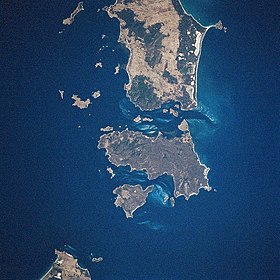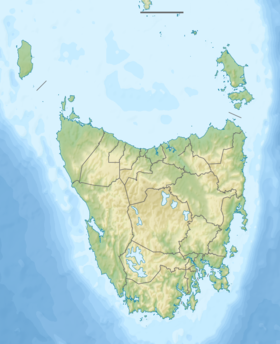The Great Dog Island, also known as Big Dog Island, and part of the Great Dog Group within the Furneaux Group, is a 354-hectare (870-acre) granite island, located in Bass Strait, lying south of the Flinders Island and north of the Cape Barren Island, in Tasmania, in south-eastern Australia.[2][3]
Nickname: Big Dog Island | |
|---|---|
 Great Dog Island (centre) from space, January 1997 | |
Location of the Great Dog Island in Bass Strait | |
| Geography | |
| Location | Bass Strait |
| Coordinates | 40°18′00″S 147°54′36″E / 40.30000°S 147.91000°E[1] |
| Archipelago | Great Dog Group, part of the Furneaux Group |
| Area | 3.75 km2 (1.45 sq mi) |
| Administration | |
Australia | |
| State | Tasmania |
| LGA | Municipality of Flinders Island |
| Largest settlement | Great Dog Island village (pop. 10) |
| Demographics | |
| Population | 10 (2014) |
| Pop. density | 2.67/km2 (6.92/sq mi) |
The island is private property and has been severely affected by grazing livestock, fire, muttonbirding and the introduction of exotic animals.[4][5] The island is part of the Franklin Sound Islands Important Bird Area, identified as such by BirdLife International because it holds over 1% of the world populations of six bird species.[6]
History
editGeorge Robinson visited the island in the 1830s and records sealers taking mutton birds there in 1837.[7]
Great Dog Island Group
editThe Great Dog Island Group includes:
Flora and fauna
editThe island's vegetation is dominated by the grass Poa poiformis, aided by the burrowing and fertilising activities of the shearwaters in conjunction with regular burning-off. However, at the north-eastern side of the island, there is a remnant mixed forest community, rare within the Furneaux Group, of manna gum and Acacia verticillata with various species of Allocasuarina, Melaleuca and Leptospermum.
Recorded breeding seabird and wader species are short-tailed shearwater (about 300,000 pairs), white-faced storm-petrel, sooty oystercatcher and pied oystercatcher. Reptiles present include the metallic skink, spotted skink, eastern three-lined skink, eastern blue-tongued lizard, lowland copperhead and tiger snake. A native mammal recorded from the island is the rakali, along with introduced mice, rats and feral cats.[5]
See also
editReferences
edit- ^ "Cape Barren Island, Tasmania (Islands & Reefs)". Gazetteer of Australia online. Geoscience Australia, Australian Government.
- ^ "Great Dog Island (TAS)". Gazetteer of Australia online. Geoscience Australia, Australian Government.
- ^ "Small Bass Strait Island Reserves. Draft Management Plan". Department of Primary Industries,Water and Environment, Tasmanian Government. October 2000. Archived from the original on 30 March 2011. Retrieved 4 February 2012.
- ^ Hayde, Kevin Anthony (1992). "Ecology of the feral cat Felis catus on Great Dog Island". Retrieved 26 December 2011.
- ^ a b Brothers, Nigel; Pemberton, David; Pryor, Helen; & Halley, Vanessa. (2001). Tasmania’s Offshore Islands: seabirds and other natural features. Tasmanian Museum and Art Gallery: Hobart. ISBN 0-7246-4816-X
- ^ "BirdLife Data Zone Franklin Sound Islands". BirdLife International. Retrieved 26 May 2017.
- ^ Kostoglou, Parry (1996). Sealing in Tasmania (First ed.). Hobart: Parks and Wildlife Service. p. 108.
